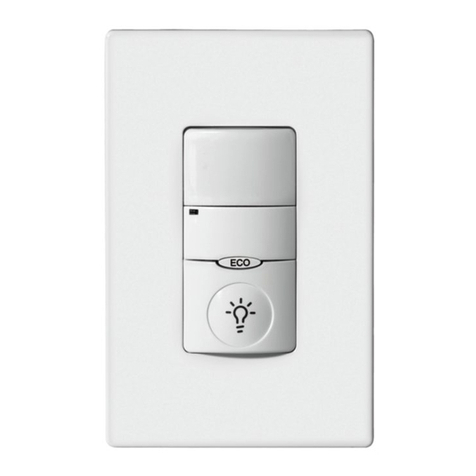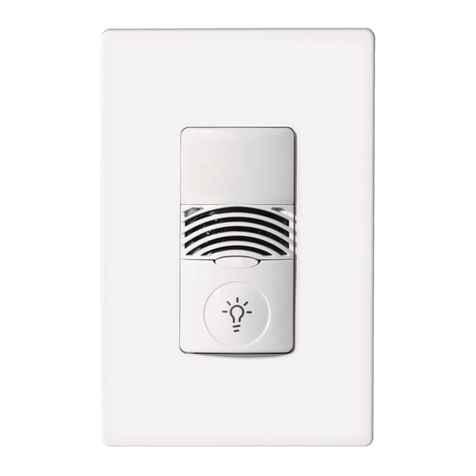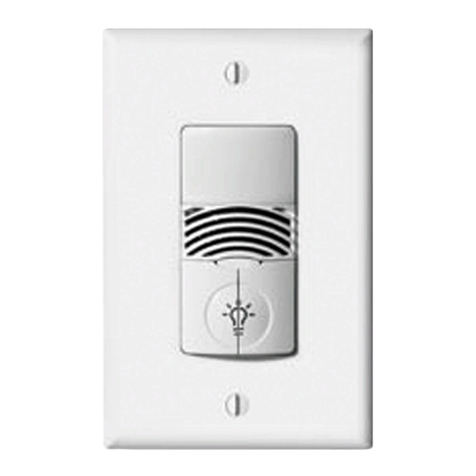
CHECKOUT AND ADJU TMENT
TROUBLE HOOTING GUIDE
OVERRIDE WITCH
P/ 910-0466
REV C
All products manufactured by Cooper Controls and identified with the Greengate brand are warranted to be free from defects in material and workmanship and shall conform
to and perform in accordance with Seller’s written specifications for a period of :
Five (5) years from date of shipment for all occupancy sensors and Three (3) years from date of factory invoice for our hardware and software on Lighting Control Panels.
We warranty all our standard relays for a period of 10 years from date of factory invoice. We guarantee the performance of our system to specifications or your money back.
This warranty will be limited to the repair or replacement, at Seller’s discretion, of any such goods found to be defective, upon their authorized return to Seller. This limited
warranty does not apply if the goods have been damaged by accident, abuse, misuse, modification or misapplication, by damage during shipment or by improper service.
There are no warranties, which extend beyond the hereinabove-limited warranty, I CLUDI G, BUT OT LIMITED TO, THE IMPLIED WARRA TY OF MERCHA TABILITY
A D THE IMPLIED WARRA TY OF FIT ESS. o employee, agent, dealer, or other person is authorized to give any warranties on behalf of the Seller or to assume for the
Seller any other liability in connection with any of its goods except in writing and signed by the Seller. The Seller makes no representation that the goods comply with any pre-
sent or future federal, state or local regulation or ordinance. Compliance is the Buyer’s responsibility. The use of the Seller’s goods should be in accordance with the provision
of the ational Electrical Code, UL and/or other industry or military standards that are pertinent to the particular end use. Installation or use not in accordance with these
codes and standards could be hazardous.
An Override switch is located under the OSW-P-0451-347 touchplate.
This switch should remain in the OFF position at all times, except in the
event of unit malfunction. Move the DIP switch to O to override the
Sensor and turn the lights on.
347 VAC
BLACK
BLUE
GREEN
347 VAC GROUND
NEUTRAL
LOAD 1
Single Level Switching
BARE WIRE
GROUND
347 VAC
BLACK
BLUE
GREEN
347 VAC GROUND
NEUTRAL
LOAD 1 LOAD 2
TOGGLE SWITCH
LOAD 2 SWITCHLEGLOAD 1 SWITCHLEG
Dual Level Switching
Using Additional Toggle Switch
BARE WIRE
GROUND
347 VAC
BLACK
BLUE
GREEN
347 VAC GROUND
NEUTRAL
LOAD 1
BLACK
BLUE
GREEN
347 VAC GROUND
NEUTRAL
Three-way wiring diagram:
Lights will turn-o automatically when
sensor that detected motion last, times out.
TRAVELLERS
BARE WIRE
GROUND
BARE WIRE
GROUND
FIGURE 2
FIGURE 3
FIGURE 1
1. Immediately after applying power to the lighting circuit, wait approximately one to two minutes for the switch to power up and stabilize.
2. The “Self Adjust” feature is set to on. The switch will continually adjust time delay and sensitivity to ensure maximum performance. o adjustments are
necessary at installation. Coverage and sensitivity can be confirmed by watching the LED indicator on the front of the Sensor while moving around the
room. The LED lights only when the Sensor is detecting motion.
3. In preparation for the Installer Test, the time delay has been set to 15 seconds (refer to the chart
below to see Time Delay settings) and the Auto/Manual switch is in the OFF position to allow for
Auto Operation (lights will turn on automatically when the switch detects movement). Leave the
room. The lights should go out in approximately 15 seconds. Wait at least 12 seconds after the
lights go out. Walk normally back into the room and verify that the lights turn on automatically.
There is no immediate need to make further adjustments to the Time Delay. When the Time Delay
is set at the installer setting, it will reset itself to the 10-minute delay one hour after the lights are shut
off automatically or manually. A 10-minute Time Delay is ideal in most applications. To disable this
self-resetting feature, move the Self-Adjust DIP switch (6) to O .
4. People who remain very still for long periods may need a longer Time Delay than the default setting
of 10 minutes. As long as the Self-Adjust feature is enabled, the switch will respond to each pair of
false offs with no normal off in between, by alternately making slight adjustments to either time delay
or sensitivity so there should be no need for manual adjustment. If manual adjustment is desired,
refer to the chart at right and use the dip switches to increase the time delay slightly, repeating if
necessary, until an optimum interval is obtained. OTE: To reset the wall switch to the factory set-
tings for sensitivity and time delay, move the Override DIP switch (8) to the O and then the OFF
settings.
5. If the LED blinks when there is no movement in the room, it is possible that the Sensor is being acti-
vated by air flow from the HVAC system or other climate control device. If possible, relocate the
Sensor at least six feet away from any climate control device.
6. If the sensor is activated by passers-by in the hallway, decrease the sensor’s field-of-view using the
tape strips provided. There are two strips that are 0.25” long and two strips that are 0.35” long.
Each strip is 0.5” wide, allowing the strip to completely cover the sensor window from top to bottom.
Start with one of the longer tape strips. Place the strip against the outermost edge of the sensor window, so that it completely covers the window, and wrap
the tape around the sensor toward the center of the window. If this does not completely prevent activation by passers-by, layer one of the remaining strips of
tape over the piece you have already placed on the sensor window, so that you cover slightly more of the sensor’s field of view. Repeat, if necessary.
7. For maximum energy savings, Model OSW-P-0451-MV can be set to Manual On by moving the “Auto/Manual On” DIP switch (5) to the O position. In this
setting, the occupant must push the touchplate to turn on lights upon entering the room.
8- OVERRIDE
4- TIME DELAY
3 - TIME DELAY
2- TIME DELAY
1 - TIME DELAY
7- ENERGY SAVER (DUAL LEVEL ONLY)
6- SELF ADJUST DISABLE
5 - AUTO/MANUAL ON
DIP SWITCH CONTROL LEGEND:
2
0.25
SWITCH NUMBER
6
4
TIME DELAY
123
8
10
12
14
(MINUTES) 4
30
18
24
26
28
22
20
16
TIME DELAY LEGEND
=On = O
Once installation is complete, restore power to the lighting circuit. Proper operation must be verified. Each unit is shipped with all DIP switches in the
default OFF position. For most applications, this is the ideal configuration and no further adjustments will be necessary. Simply complete the installer
test described below to confirm. If adjustments are necessary, DIP switches are under the touchplate. Adjustments should be made with the HVAC
system on so that the installer will be able to detect the effect of airflow on the operation of the OSW-P-0451-MV. Use only insulated tools to make
adjustments.
BEFORE PROCEEDING WITH ANY TROUBLE HOOTING: Confirm the
Override DIP switch (8) is in the OFF or down position. If it is in the O or up
position, switch it to the OFF position and wait two minutes before proceed-
ing.
LED will not turn ON: Verify that the lighting circuit has power.
Immediately after power is applied to the lighting circuit, it takes approximate-
ly one to two minutes for the OSW-P-0451-MV to stabilize. Once the switch
has had time to stabilize, verify that OSW-P-0451-MV is properly adjusted.
Press the touchplate to manually turn on the lights. If the LED does not light,
replace the Sensor.
Lights will not turn ON: Immediately after power is applied to the lighting
circuit, it takes approximately one to two minutes for the OSW-P-0451-MV to
stabilize. Once the switch has had time to stabilize, if the lights will not turn
on automatically after someone enters the room, press the touchplate. If
lights come on, the OSW-P-0451-MV could be set to the Manual On mode.
Check under the touchplate to verify the setting. If OSW-P-0451-MV is set to
Automatic On mode, it may have been overridden by someone pressing the
touchplate; allow Sensor to time out to verify normal operation. If the lights
do not turn on after pressing the touchplate, confirm that no other switches or
equipment are interrupting or bypassing power to the Sensor or the load. If
lights still do not turn on, replace the Sensor.
Lights will not turn OFF: Immediately after power is applied to the lighting
circuit, it takes approximately one to two minutes for the OSW-P-0451-MV to
stabilize. Once the switch has had time to stabilize, if the lights will not turn
off after the selected time delay, and the LED has not lit during the time peri-
od, press the touchplate to manually turn off the lights. If lights turn off,
refer to items 5 and 6 above under “Checkout and Adjustment.” Confirm
that no other switches or equipment are interrupting or bypassing power
to the Sensor or the load. If lights still do not turn off, replace the Sensor.
WIRING DIAGRAM






















